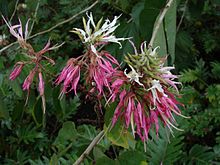
Back Bauhinia Afrikaans بوهينية Arabic بوهينيا ARZ Bauhinia Azerbaijani বনকাঞ্চন Bengali/Bangla Bauhinia Catalan Bauhinia CEB Bauhínie Czech Bauhinien German Bauhinia Spanish
| Bauhinia | |
|---|---|

| |
| Bauhinia divaricata flowers | |
| Scientific classification | |
| Kingdom: | Plantae |
| Clade: | Tracheophytes |
| Clade: | Angiosperms |
| Clade: | Eudicots |
| Clade: | Rosids |
| Order: | Fabales |
| Family: | Fabaceae |
| Subfamily: | Cercidoideae |
| Tribe: | Bauhinieae |
| Genus: | Bauhinia L. (1753)[1] |
| Type species | |
| Bauhinia divaricata Plum. ex L. (1753)
| |
| Species | |
|
192 (in 2023); see text[2] | |
| Synonyms[1][2][3] | |
| |
Bauhinia (/boʊˈhɪniə/)[4] is a large genus of flowering plants in the subfamily Cercidoideae[5] and tribe Bauhinieae,[6] in the large flowering plant family Fabaceae, with a pantropical distribution. The genus was named after the Bauhin brothers Gaspard and Johann, Swiss-French botanists.
Many species are widely planted in the tropics as orchid trees, particularly in India, Sri Lanka, Vietnam, Nepal and southeastern China. Other common names include mountain ebony and kachnar. Before the family was reorganised,[5] a number of genera including the lianas of genus Phanera were placed here (see related genera). In the United States, the trees grow in Hawaii, coastal California, Arizona, Texas, Louisiana, and Florida. There are native species, like Bauhinia lunarioides native to Texas and widely planted in the Southwest as a landscape plant.[7]
Parts of some species of bauhinia like B. purpurea and B. malabarica are used in Filipino cuisine (known collectively as alinbánban or alinbángbang,[8] "butterfly").[9]
Bauhinia × blakeana is the floral emblem of Hong Kong—a stylized orchid tree flower appears on the flag of Hong Kong and Hong Kong Airlines (formerly CR Airways) uses 'Bauhinia' as its radio callsign in air traffic communication.
- ^ a b "Genus: Bauhinia L." Germplasm Resources Information Network. United States Department of Agriculture. 2007-03-29. Archived from the original on 2012-05-03. Retrieved 2010-12-06.
- ^ a b Cite error: The named reference
POWOwas invoked but never defined (see the help page). - ^ Wunderlin RP (2010). "Reorganization of the Cercideae (Fabaceae: Caesalpinioideae)" (PDF). Phytoneuron. 48: 1–5.
- ^ Sunset Western Garden Book, 1995:606–607; OED: "Bauhinia"
- ^ a b The Legume Phylogeny Working Group (LPWG). (2017). "A new subfamily classification of the Leguminosae based on a taxonomically comprehensive phylogeny". Taxon. 66 (1): 44–77. doi:10.12705/661.3. hdl:10568/90658.
- ^ Sinou C, Forest F, Lewis GP, Bruneau A (2009). "The genus Bauhinia s.l. (Leguminosae): a phylogeny based on the plastid trnL–trnF region". Botany. 87 (10): 947–960. doi:10.1139/B09-065.
- ^ "SEINet Portal Network - Bauhinia lunarioides".
- ^ Merrill, Elmer Drew (1903). A dictionary of the plant names of the Philippine Islands. Bureau of Public Printing, Department of The Interior. p. 128 – via University of Michigan Digital Collections.
- ^ Seidemann, Johannes (2005). World Spice Plants. Berlin, Heidelberg: Springer-Verlag Berlin Heidelberg. p. 64. ISBN 9783540279082.
© MMXXIII Rich X Search. We shall prevail. All rights reserved. Rich X Search